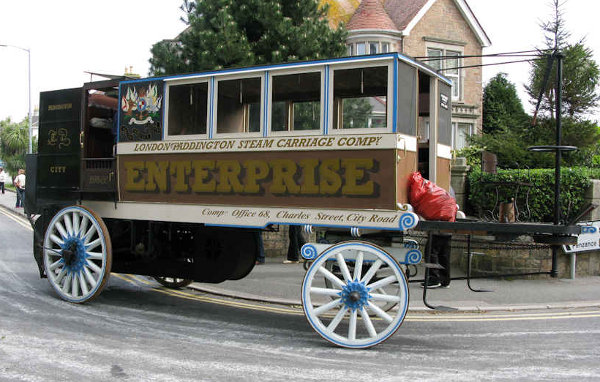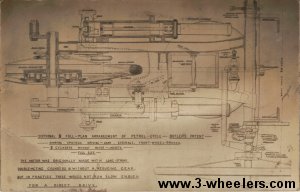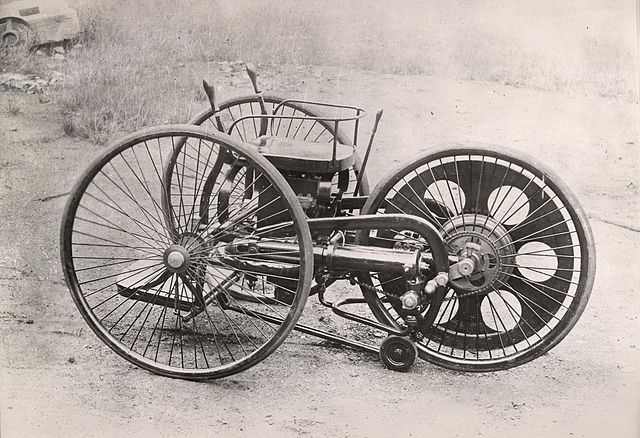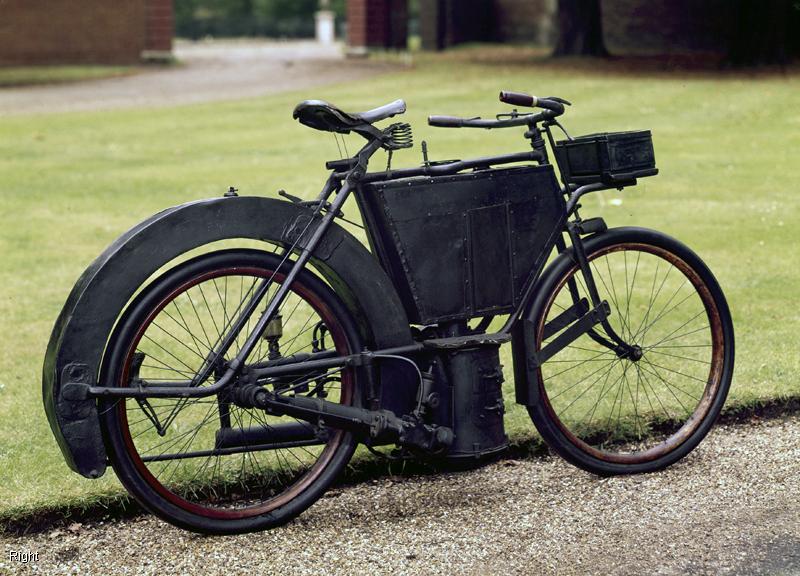
Early Steam-Powered Coach
Back in 1865 Her Majesty's Government introduced an Act of Parliament intended to regulate the use of road traffic.
Typically for an effort by politicians it had the effect of hindering rather than helping development as the legislation in question was the infamous "Red Flag Act".
This had the effect of favouring the interests of the toll road owners and the coach trade by promoting the use of horse drawn vehicles in favour of mechanically
powered ones. In other words, as usual, the monied crowd were protecting their interests.
The Act came about because of the interest being shown at that time in the use of steam power for road vehicles and it had the effect of stiffling the development
of all mechanically powered vehicles in the UK over the following 30 years

This Act required each vehicle to have a minimum crew of three men
Two had to be on the vehicle, which is reasonable for a steam driven vehicle as you would need a stoker and a steersman, but, in order that you would not "frighten the horses",
you also had to have a man walking 60 yards(55 metres) in front of the vehicle carrying a red warning flag.
Another stipulation was that, "if more than two waggons or carriages be attached thereto" there had to be a fourth crewman in charge of those carriages.
This Act also imposed a speed limit of 4 mph on rural roads but it reduced this to all of 2 mph in towns.
When you consider that 4 mph is a reasonable walking pace, you quickly realise that the horse-drawn traffic would be considerably faster than the steamers!.
Among the reasons given was that "The high speeds of the road locomotives", speeds of up to 10 mph!, was causing damage to the road surface.
The probability is in fact that the narrow wheels and "slide to a stop" braking of horse-drawn vehicles, coupled with the damage caused by the impact of the horses shod hooves on the road,
was causing more damage than the wider wheels and better brakes of the steamers.
As an instance, I have seen a horse-drawn dray (a brewery delivery vehicle) descending a hill with the horses leaning back in their harnesses to hold it back and the wheels of the dray
locked and sliding on the roads surface.
Needless to say the Act also limited the development in the UK of the use of the internal combustion engine for road use, but as always we did have the "awkward squad" who tried anyway.
It is commonly said that the first motor vehicles were Daimler's "Einspur" motorcycle in 1885 and Benz's threewheeler in 1886.
Well in 1884 Edward Butler showed the plans for a powered three-wheeler at the Stanley Cycle Show in London.

He had the "MarkII" of the vehicle, to an improved design, actually "on the road" under test by 1888. All things considered it was quite a sophisticated vehicle!.
While it was a three-wheeler, its layout had two wheels at the front and the driven wheel at the rear.
Steering was by the front wheels with lever controls and rather than having a simple cart-axle, it had the same Ackerman type steering as is used in modern cars.
Its engine had two cylinders, both lying flat and aligned fore and aft. The initial prototype was a Clerk-cycle two-stroke but this was soon altered to a four-stroke design.
It had a "High speed" design and was of 600ccs capacity, giving all of 5/8th of a horsepower at 600rpm.
It had banana like external connecting rods looping over from front of the engine to cranks on the rear axle, but it was not a direct drive to the rear wheel.
The cranks drove a set of epicyclic gears which gave a 6:1 reduction between the axle-come-crankshaft and the wheel.
Given that the wheels were 32 inches in diameter this meant that at maximum revs of 600rpm, the roadspeed would have been all of 9.7 mph!.
Among its other advanced features it had an electric ignition system rather than the primitive "hot tube" ignition of its competitors
It also had a proper spray carburettor rather than the crude "surface carburettors" they were fitted with, and this was 4 years before the spray carburettor was "invented" by Maybach!.
Not only that but it was water-cooled, using the voluminous rear mudguard as a surface radiator.


In common with the other pioneers there was a direct transmission to the rear wheel, meaning that as long as the engine was running the wheel was turning.
This means there has to be some means of "interrupting" the drive to allow vehicle to stop. Many of the early "single speeder" motorcycles in fact had to stop their engines when at a standstill.
On a modern vehicle this is done by using a friction clutch but what Butler did was to have a pair of jockey wheels, one either side of the rear wheel.
These were linked to a foot-pedal and rigged so that they would lift the rear wheel off the ground or lower it back down again.
Unfortunately Butler rapidly ran into a major problem when testing the vehicle, the Law!.
If he rode it on urban roads with their speed limit of 2mph, the engine was running at all of 123rpm!.
If however he went out a country road he could increase this to 246rpm! and he had to be careful as the law was rigorously enforced at the behest of the entrenched interests.
In 1890 Butler abandoned development of his machine saying in a magazine article that "The authorities do not countenance its use on the roads, and I have abandoned in consequence any further
development of it."
Subsequently in 1896 the vehicle was broken up for scrap-metal.
Later that same year the government passed the "Locomotives on the Highway" act which raised the speed limit to a heady 12 mph and did away with the crewing requirement.
After the new Act came into force Harry Lawson, a name infamous in early UK motoring, organised the "Emancipation Run" where Saturday 14th November 1896 the entrants had to cover the
distance between London and Brighton
The two fastest vehicles were both petrol powered three wheelers!
If only Butler had known what was in the minds of the government!
As a side-note, entry No.18 in the run was a "Steam Motorcycle" ridden by a Frenchman, Mssr Lormont.

The machine pictured was abandoned for many years in the Newhaven Railway depot with the legend that it had taken part in the Emancipation Run until in 1940 it was obtained by the Science Museum
In 1956 it was identified as the prototype of the Hildebrand steam motorcycle and it is known that Lormont was with Hildebrand in 1894 so it is probable that this machine did take part in that Run and
serves as an example of what Butler's competition was.
This run was revived in 1927 and has since gained international status as the "London to Brighton" run.
With the exception of the war years it has been held every year since and it is strictly for vehicles made before 1905.